The safety of our visitors, staff and of our neighbors is our top priority at Crab Orchard National Wildlife Refuge. As the result of massive flooding, erosion and deterioration due to climate change climate change
Climate change includes both global warming driven by human-induced emissions of greenhouse gases and the resulting large-scale shifts in weather patterns. Though there have been previous periods of climatic change, since the mid-20th century humans have had an unprecedented impact on Earth's climate system and caused change on a global scale.
Learn more about climate change , we have reevaluated our existing infrastructure management planning and will be completely draining the Little Grassy Lake starting this month.
Out of an abundance of caution, the U.S. Fish and Wildlife Service has determined that a proactive approach and drawdown of this public resource are necessary to protect communities downstream. This decision aims to minimize future impacts to Little Grassy Lake Dam and Crab Orchard Lake Dam. Crab Orchard Lake Dam also has compromised gates, which could be further impacted with a failure of the spillway at Little Grassy Lake. Given that Little Grassy Lake was built upstream of Crab Orchard Lake, this series of dams could set off a cascade of infrastructure failures if the dam at Little Grassy Lake fails and would result in loss of life and property in downstream Carbondale, Illinois and closer neighboring communities.
“These proactive measures aim to keep everyone as safe as possible given our concerns with the current condition of the refuge’s aging infrastructure,” said Deb Beck, Infrastructure Management Division Midwest Region, National Wildlife Refuge System.
In addition, the refuge has been in the early stages of what is expected to be a two-year process to evaluate and rehabilitate the Little Grassy Lake Dam and Spillway. This is in coordination with the U.S. Army Corps of Engineers St. Louis District through the formal Little Grassy Lake Dam Modification Study, which began on September 10, 2024. This project will continue under this new dewatered management strategy, given the heightened risk and public safety concerns.
Draining the lake during the dam remediation process will help to address concerns about the current condition of a compromised service spillway, should it be activated by extreme weather events. Reducing the water level proactively will lessen the likelihood for a dam failure until repairs can be designed and completed to the structure structure
Something temporarily or permanently constructed, built, or placed; and constructed of natural or manufactured parts including, but not limited to, a building, shed, cabin, porch, bridge, walkway, stair steps, sign, landing, platform, dock, rack, fence, telecommunication device, antennae, fish cleaning table, satellite dish/mount, or well head.
Learn more about structure .
The Little Grassy Lake Dam and Spillway structure on the refuge has aged beyond its engineered design life. Constructed in 1942, the dam is currently operating under an emergency action plan due to issues discovered in the spillway as part of a recent inspection. Encompassing 1,000 acres, Little Grassy Lake is one of three reservoirs with high hazard dams within the refuge that need repair. All three reservoirs are vital to fish and wildlife, outdoor recreation and the socioeconomic vitality of the region.
In addition to completely draining the impounded lake, the outlet works gate is planned to be left open in the interim. This will allow all in-flowing water to pass at safer levels without a new build-up of water.
We will continue to provide visitors, concessionaires and the local community updates as the drawdown progresses over the winter months. Please visit our refuge website for the latest information.
You are also welcome to contact the refuge headquarters for additional information at 618-997-3344, or email the team at craborchard@fws.gov. You can also write with questions: Refuge Manager, 8588 Route 148, Marion, Il 62959.




